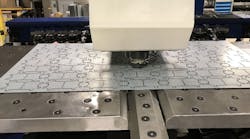A manufacturer that punches out several parts from a single sheet of steel was having a problem with oil occasionally spraying out from between two hydraulic valve sandwich modules. They would disassemble the D03 valve stack and find one of the O-rings completely gone.
The valve stack had been taken apart several times over the last three years, and only new O-rings were installed. Viton 95-durometer O-rings were used because they have a Shore durometer slightly higher than 70.
The press ran four years without a failure, and no one remembered the reason for the first failure. Typically, a missing O-ring is a sign of high vacuum, but the circuit compensated for this with a module from Sun Hydraulics containing an anti-cavitation check valve. They unscrewed the anti-cavity check cartridge and found it to be working well.
Any idea why this would happen?
Find the Solution
Think you know the answer to this month’s problem? Submit your solution via e-mail. All correct answers submitted by June 24, 2018 will be entered into a random drawing for a $50 gift card. The winner will be notified, and his or her name will be printed in a future issue. Only one gift card will be awarded to any participant within a calendar year.
Solution to Last Month’s Challenge:
Shaft Seal Fails on Pressure-Compensated Pump
Shaft seal failures where the seal lip is pushed out normally are evidence that the case pressures are spiking higher than they should. (Another cause could be shaft misalignment, but this is uncommon with C-face mounted pumps.) Glycerin-filled gauges with an orifice cannot respond fast enough to indicate true pressure spikes, which last for only 5 to 10 milliseconds. Installing a direct-operated relief valve designed to limit pressure spikes between the pump and the closed-center valve solved the problem.


